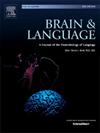额叶脑电图伽玛功率是幼儿期语言的神经相关因素吗?对晚期说话和语言表达能力的研究。
IF 2.3
2区 心理学
Q1 AUDIOLOGY & SPEECH-LANGUAGE PATHOLOGY
引用次数: 0
摘要
很少有研究对幼儿晚说话的神经相关性进行研究,而这有助于了解发育性语言障碍(DLD)的病因并改进诊断。额叶伽马活动的增加与语言能力的提高有关,但研究结果因发育障碍的风险而异,而且尚未对晚期说话者进行研究。本研究考察了基线状态脑电图(EEG)显示的额叶伽玛功率(30-50赫兹)是否与DLD风险(分类的晚说话状态)有关,并对124名幼儿的语言表达能力进行了连续测量。在控制人口统计学因素和同时接受语言的情况下,额叶伽玛功率与晚说话状态有显著相关性(β = 1.96,麦克法登伪R2 = 0.21)。人口统计学因素和接受性语言并不能显著调节额叶伽玛功率与晚说话者身份之间的关系。语言表达能力的连续测量与伽马值(r = -0.07)无明显关联。研究结果表明,额叶伽玛功率可能有助于区分患有迟缓性失语症风险不同的儿童群体,但对于表达语言能力的连续测量则没有作用。本文章由计算机程序翻译,如有差异,请以英文原文为准。
Is frontal EEG gamma power a neural correlate of language in toddlerhood? An examination of late talking and expressive language ability
Few studies have examined neural correlates of late talking in toddlers, which could aid in understanding etiology and improving diagnosis of developmental language disorder (DLD). Greater frontal gamma activity has been linked to better language skills, but findings vary by risk for developmental disorders, and this has not been investigated in late talkers. This study examined whether frontal gamma power (30–50 Hz), from baseline-state electroencephalography (EEG), was related to DLD risk (categorical late talking status) and a continuous measure of expressive language in n = 124 toddlers. Frontal gamma power was significantly associated with late talker status when controlling for demographic factors and concurrent receptive language (β = 1.96, McFadden’s Pseudo R2 = 0.21). Demographic factors and receptive language did not significantly moderate the association between frontal gamma power and late talker status. A continuous measure of expressive language ability was not significantly associated with gamma (r = -0.07). Findings suggest that frontal gamma power may be useful in discriminating between groups of children that differ in DLD risk, but not for expressive language along a continuous spectrum of ability.
求助全文
通过发布文献求助,成功后即可免费获取论文全文。
去求助
来源期刊

Brain and Language
医学-神经科学
CiteScore
4.50
自引率
8.00%
发文量
82
审稿时长
20.5 weeks
期刊介绍:
An interdisciplinary journal, Brain and Language publishes articles that elucidate the complex relationships among language, brain, and behavior. The journal covers the large variety of modern techniques in cognitive neuroscience, including functional and structural brain imaging, electrophysiology, cellular and molecular neurobiology, genetics, lesion-based approaches, and computational modeling. All articles must relate to human language and be relevant to the understanding of its neurobiological and neurocognitive bases. Published articles in the journal are expected to have significant theoretical novelty and/or practical implications, and use perspectives and methods from psychology, linguistics, and neuroscience along with brain data and brain measures.
 求助内容:
求助内容: 应助结果提醒方式:
应助结果提醒方式:


